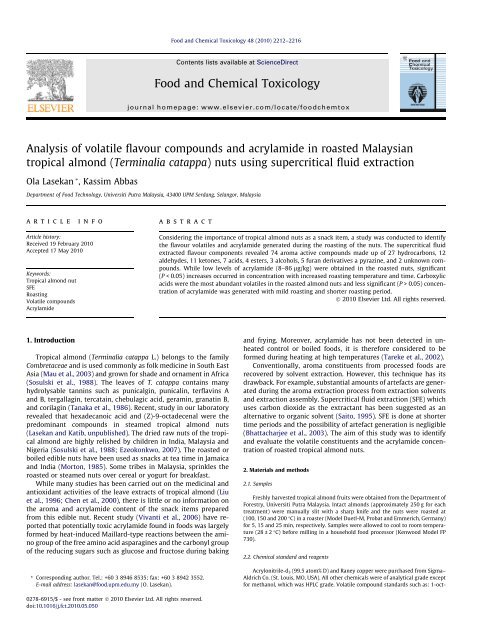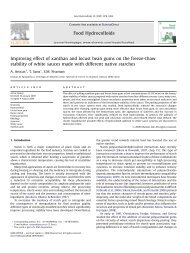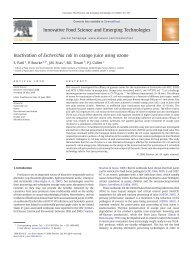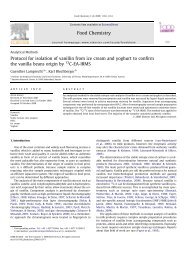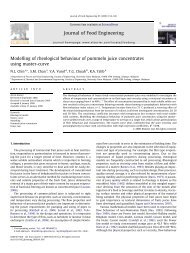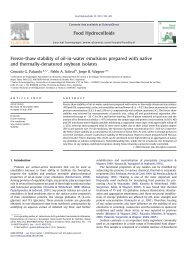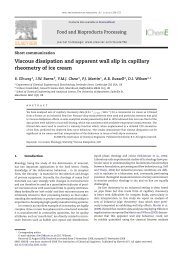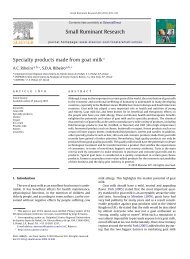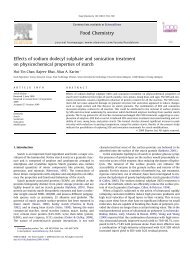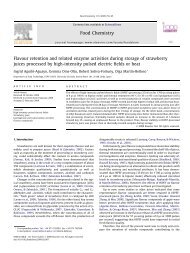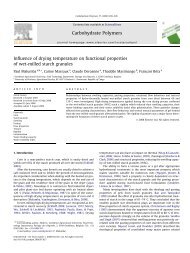Analysis of volatile flavour compounds and acrylamide in roasted ...
Analysis of volatile flavour compounds and acrylamide in roasted ...
Analysis of volatile flavour compounds and acrylamide in roasted ...
Create successful ePaper yourself
Turn your PDF publications into a flip-book with our unique Google optimized e-Paper software.
<strong>Analysis</strong> <strong>of</strong> <strong>volatile</strong> <strong>flavour</strong> <strong>compounds</strong> <strong>and</strong> <strong>acrylamide</strong> <strong>in</strong> <strong>roasted</strong> Malaysian<br />
tropical almond (Term<strong>in</strong>alia catappa) nuts us<strong>in</strong>g supercritical fluid extraction<br />
Ola Lasekan *, Kassim Abbas<br />
Department <strong>of</strong> Food Technology, Universiti Putra Malaysia, 43400 UPM Serdang, Selangor, Malaysia<br />
article <strong>in</strong>fo<br />
Article history:<br />
Received 19 February 2010<br />
Accepted 17 May 2010<br />
Keywords:<br />
Tropical almond nut<br />
SFE<br />
Roast<strong>in</strong>g<br />
Volatile <strong>compounds</strong><br />
Acrylamide<br />
1. Introduction<br />
abstract<br />
Tropical almond (Term<strong>in</strong>alia catappa L.) belongs to the family<br />
Combretaceae <strong>and</strong> is used commonly as folk medic<strong>in</strong>e <strong>in</strong> South East<br />
Asia (Mau et al., 2003) <strong>and</strong> grown for shade <strong>and</strong> ornament <strong>in</strong> Africa<br />
(Sosulski et al., 1988). The leaves <strong>of</strong> T. catappa conta<strong>in</strong>s many<br />
hydrolysable tann<strong>in</strong>s such as punicalg<strong>in</strong>, punical<strong>in</strong>, terflav<strong>in</strong>s A<br />
<strong>and</strong> B, tergallag<strong>in</strong>, tercata<strong>in</strong>, chebulagic acid, geram<strong>in</strong>, granat<strong>in</strong> B,<br />
<strong>and</strong> corilag<strong>in</strong> (Tanaka et al., 1986). Recent, study <strong>in</strong> our laboratory<br />
revealed that hexadecanoic acid <strong>and</strong> (Z)-9-octadecenal were the<br />
predom<strong>in</strong>ant <strong>compounds</strong> <strong>in</strong> steamed tropical almond nuts<br />
(Lasekan <strong>and</strong> Katib, unpublished). The dried raw nuts <strong>of</strong> the tropical<br />
almond are highly relished by children <strong>in</strong> India, Malaysia <strong>and</strong><br />
Nigeria (Sosulski et al., 1988; Ezeokonkwo, 2007). The <strong>roasted</strong> or<br />
boiled edible nuts have been used as snacks at tea time <strong>in</strong> Jamaica<br />
<strong>and</strong> India (Morton, 1985). Some tribes <strong>in</strong> Malaysia, spr<strong>in</strong>kles the<br />
<strong>roasted</strong> or steamed nuts over cereal or yogurt for breakfast.<br />
While many studies has been carried out on the medic<strong>in</strong>al <strong>and</strong><br />
antioxidant activities <strong>of</strong> the leave extracts <strong>of</strong> tropical almond (Liu<br />
et al., 1996; Chen et al., 2000), there is little or no <strong>in</strong>formation on<br />
the aroma <strong>and</strong> <strong>acrylamide</strong> content <strong>of</strong> the snack items prepared<br />
from this edible nut. Recent study (Vivanti et al., 2006) have reported<br />
that potentially toxic <strong>acrylamide</strong> found <strong>in</strong> foods was largely<br />
formed by heat-<strong>in</strong>duced Maillard-type reactions between the am<strong>in</strong>o<br />
group <strong>of</strong> the free am<strong>in</strong>o acid asparag<strong>in</strong>es <strong>and</strong> the carbonyl group<br />
<strong>of</strong> the reduc<strong>in</strong>g sugars such as glucose <strong>and</strong> fructose dur<strong>in</strong>g bak<strong>in</strong>g<br />
* Correspond<strong>in</strong>g author. Tel.: +60 3 8946 8535; fax: +60 3 8942 3552.<br />
E-mail address: lasekan@food.upm.edu.my (O. Lasekan).<br />
0278-6915/$ - see front matter Ó 2010 Elsevier Ltd. All rights reserved.<br />
doi:10.1016/j.fct.2010.05.050<br />
Food <strong>and</strong> Chemical Toxicology 48 (2010) 2212–2216<br />
Contents lists available at ScienceDirect<br />
Food <strong>and</strong> Chemical Toxicology<br />
journal homepage: www.elsevier.com/locate/foodchemtox<br />
Consider<strong>in</strong>g the importance <strong>of</strong> tropical almond nuts as a snack item, a study was conducted to identify<br />
the <strong>flavour</strong> <strong>volatile</strong>s <strong>and</strong> <strong>acrylamide</strong> generated dur<strong>in</strong>g the roast<strong>in</strong>g <strong>of</strong> the nuts. The supercritical fluid<br />
extracted <strong>flavour</strong> components revealed 74 aroma active <strong>compounds</strong> made up <strong>of</strong> 27 hydrocarbons, 12<br />
aldehydes, 11 ketones, 7 acids, 4 esters, 3 alcohols, 5 furan derivatives a pyraz<strong>in</strong>e, <strong>and</strong> 2 unknown <strong>compounds</strong>.<br />
While low levels <strong>of</strong> <strong>acrylamide</strong> (8–86 lg/kg) were obta<strong>in</strong>ed <strong>in</strong> the <strong>roasted</strong> nuts, significant<br />
(P < 0.05) <strong>in</strong>creases occurred <strong>in</strong> concentration with <strong>in</strong>creased roast<strong>in</strong>g temperature <strong>and</strong> time. Carboxylic<br />
acids were the most abundant <strong>volatile</strong>s <strong>in</strong> the <strong>roasted</strong> almond nuts <strong>and</strong> less significant (P > 0.05) concentration<br />
<strong>of</strong> <strong>acrylamide</strong> was generated with mild roast<strong>in</strong>g <strong>and</strong> shorter roast<strong>in</strong>g period.<br />
Ó 2010 Elsevier Ltd. All rights reserved.<br />
<strong>and</strong> fry<strong>in</strong>g. Moreover, <strong>acrylamide</strong> has not been detected <strong>in</strong> unheated<br />
control or boiled foods, it is therefore considered to be<br />
formed dur<strong>in</strong>g heat<strong>in</strong>g at high temperatures (Tareke et al., 2002).<br />
Conventionally, aroma constituents from processed foods are<br />
recovered by solvent extraction. However, this technique has its<br />
drawback. For example, substantial amounts <strong>of</strong> artefacts are generated<br />
dur<strong>in</strong>g the aroma extraction process from extraction solvents<br />
<strong>and</strong> extraction assembly. Supercritical fluid extraction (SFE) which<br />
uses carbon dioxide as the extractant has been suggested as an<br />
alternative to organic solvent (Saito, 1995). SFE is done at shorter<br />
time periods <strong>and</strong> the possibility <strong>of</strong> artefact generation is negligible<br />
(Bhattacharjee et al., 2003). The aim <strong>of</strong> this study was to identify<br />
<strong>and</strong> evaluate the <strong>volatile</strong> constituents <strong>and</strong> the <strong>acrylamide</strong> concentration<br />
<strong>of</strong> <strong>roasted</strong> tropical almond nuts.<br />
2. Materials <strong>and</strong> methods<br />
2.1. Samples<br />
Freshly harvested tropical almond fruits were obta<strong>in</strong>ed from the Department <strong>of</strong><br />
Forestry, Universiti Putra Malaysia. Intact almonds (approximately 250 g for each<br />
treatment) were manually slit with a sharp knife <strong>and</strong> the nuts were <strong>roasted</strong> at<br />
(100, 150 <strong>and</strong> 200 °C) <strong>in</strong> a roaster (Model Duetl-M, Probat <strong>and</strong> Emmerich, Germany)<br />
for 5, 15 <strong>and</strong> 25 m<strong>in</strong>, respectively. Samples were allowed to cool to room temperature<br />
(28 ± 2 °C) before mill<strong>in</strong>g <strong>in</strong> a household food processor (Kenwood Model FP<br />
730).<br />
2.2. Chemical st<strong>and</strong>ard <strong>and</strong> reagents<br />
Acrylonitrile-d 3 (99.5 atom% D) <strong>and</strong> Raney copper were purchased from Sigma–<br />
Aldrich Co. (St. Louis, MO, USA). All other chemicals were <strong>of</strong> analytical grade except<br />
for methanol, which was HPLC grade. Volatile compound st<strong>and</strong>ards such as: 1-oct-
anol, decanal, octanal, nonanal, hept-2-enal, (E, E)-2,4-nonadienal, (E, E)-2,4-decadienal,<br />
hexadecanoic acid, octadecanoic acid, decanoic acid, octanoic acid, heptanone,<br />
furfuryl octanoate were obta<strong>in</strong>ed from (Aldrich, Ste<strong>in</strong>heim, Germany).<br />
Gamma-dodecalactone <strong>and</strong> 2-ethyl-3,6-dimethylpyraz<strong>in</strong>e were obta<strong>in</strong>ed from (Acros,<br />
Organics, New Jersey, USA).<br />
Stock st<strong>and</strong>ard solutions <strong>of</strong> 10 3 or 10 4 mg L 1 <strong>of</strong> each component was prepared<br />
by dissolv<strong>in</strong>g the pure st<strong>and</strong>ard <strong>in</strong> 40% (v/v) ethanol. The samples were stored at<br />
4 °C. Work<strong>in</strong>g st<strong>and</strong>ard solutions were prepared daily by mix<strong>in</strong>g an aliquot <strong>of</strong> each<br />
<strong>in</strong>dividual solution <strong>and</strong> dilut<strong>in</strong>g with ultra pure water (Millipore Co., Bedford, USA)<br />
to obta<strong>in</strong> a f<strong>in</strong>al ethanol content <strong>of</strong> 10% (v/v).<br />
2.3. Synthesis <strong>of</strong> <strong>acrylamide</strong>-d 3 as an <strong>in</strong>ternal st<strong>and</strong>ard<br />
Acrylonitrile-d 3 (1 g) was dissolved <strong>in</strong> water (30 ml) <strong>and</strong> added to Raney copper<br />
(5 g) <strong>in</strong> a flask. The mixture was stirred at 80 °C for 3 h under nitrogen atmosphere.<br />
Acrylamide-d3 was obta<strong>in</strong>ed as a colourless solid (957 mg) after suction filtration<br />
<strong>and</strong> lyophilisation. The material was purified by sublimation before use.<br />
2.4. Extraction procedure for aroma analysis<br />
A laboratory-scale SFE system (Thar Model 500, Thar Technologies Inc., <strong>and</strong><br />
Pittsburgh, PA, USA) was used <strong>in</strong> this study. The 500 ml extraction cell was made<br />
<strong>of</strong> sta<strong>in</strong>less steel (Type 316), with a sta<strong>in</strong>less-steel frit. The ground almond nuts<br />
were mixed with glass wool <strong>in</strong> the ratio <strong>of</strong> 25:1 (w/w), packed <strong>in</strong> a sample cartridge.<br />
The filled cartridge was <strong>in</strong>serted <strong>in</strong>to the thermal-controlled extraction cell. Liquefied<br />
CO 2 was <strong>in</strong>troduced <strong>in</strong>to the sample cartridge through a piston pump with a<br />
cool<strong>in</strong>g jacket. Both the pressure <strong>and</strong> temperature <strong>of</strong> the cartridge were automatically<br />
reached <strong>and</strong> ma<strong>in</strong>ta<strong>in</strong>ed by a control unit accord<strong>in</strong>g to sett<strong>in</strong>gs. After the desired<br />
pressure <strong>and</strong> temperature were reached, the cell was placed <strong>in</strong> the oven cavity<br />
<strong>and</strong> connected to the manifold <strong>and</strong> the restrictors. The system was held for 30 m<strong>in</strong><br />
under the desired conditions, <strong>and</strong> then carbon dioxide was allowed to flow cont<strong>in</strong>uously<br />
through the extractor for 3 h. The flow rate <strong>of</strong> CO2 was regulated by both the<br />
pressure-releas<strong>in</strong>g valve <strong>and</strong> a thermal-controlled restrictor <strong>and</strong> monitored by a<br />
flow metre. Extracts were f<strong>in</strong>ally separated from CO 2 phase <strong>and</strong> collected <strong>in</strong> a collector<br />
at ambient temperature <strong>and</strong> atmospheric pressure. The nut residue was further<br />
extracted with small amount <strong>of</strong> methanol added as a modifier to CO 2 <strong>in</strong> a ratio<br />
<strong>of</strong> 1:9 (methanol:CO 2). The extracts were pooled together <strong>and</strong> stored at 18 °C for<br />
5h.<br />
Table 1<br />
Characteristics <strong>of</strong> the calibration curves.<br />
2.5. Concentration <strong>of</strong> aroma extracts<br />
The aroma extracts obta<strong>in</strong>ed from the SFE, were spiked with 15 ll decanal<br />
(<strong>in</strong>ternal st<strong>and</strong>ard) <strong>and</strong> stirred for 30 m<strong>in</strong> for equilibration. The aroma extracts<br />
were later dried over a bed <strong>of</strong> anhydrous Na2SO4 <strong>and</strong> f<strong>in</strong>ally concentrated to<br />
100 ll by slowly purg<strong>in</strong>g nitrogen gas (commercial grade) over the sample. Samples<br />
were stored <strong>in</strong> screw-capped glass (wrapped with Teflon tape) at 18 °C prior to<br />
analysis.<br />
2.6. Extraction procedure for <strong>acrylamide</strong><br />
F<strong>in</strong>ely ground samples <strong>of</strong> tropical almond nuts (50 g) were each weighed <strong>in</strong>to<br />
an Erlenmeyer flask (500 ml) with a plug <strong>and</strong> <strong>acrylamide</strong>-d 3 solution was added<br />
with constant shak<strong>in</strong>g for 5 m<strong>in</strong>. This was followed by the addition <strong>of</strong> 300 ml <strong>of</strong><br />
water. The mixture was homogenised at high speed for 3 m<strong>in</strong> us<strong>in</strong>g an Ultra Turrax<br />
(OpticsPlanet, Inc., Northbrook, IL, USA). The extract was poured <strong>in</strong>to centrifuge<br />
tubes (50 ml) <strong>and</strong> centrifuged at 20,000 rpm (48,000 g) for 20 m<strong>in</strong> at 2 °C. The aqueous<br />
phase <strong>of</strong> the supernatant was poured <strong>in</strong>to plastic tubes (2 ml) <strong>and</strong> stored at<br />
30 °C. The frozen extracts were thawed <strong>in</strong> water bath at room temperature <strong>and</strong><br />
centrifuged at 15,000 rpm (21,700 g) for 10 m<strong>in</strong>. Each result<strong>in</strong>g supernatant was<br />
subjected to a solid-phase extraction cartridge (I solute Multimode, 500 mg; International<br />
Sorbent Technology, Hengoed, Glamorgan, UK), which had been conditioned<br />
with methanol (1 ml) <strong>and</strong> water (2 ml), <strong>and</strong> eluted with water. After<br />
discard<strong>in</strong>g the first 1 ml <strong>of</strong> the eluate, 2 ml eluate were collected <strong>and</strong> used for the<br />
LC–MS analysis <strong>of</strong> <strong>acrylamide</strong>.<br />
2.7. GC–MS analysis<br />
The extracts were analyzed us<strong>in</strong>g a Shimadzu (Kyoto, Japan) QP-5050A GC–MS<br />
<strong>in</strong>strument equipped with a GC-17A Ver. 3 gas chromatograph with a flame ionization<br />
detector (FID). The column was a non-polar BP X 5 (5% phenylpolysilphenylenesiloxane)<br />
capillary columns (30 m 0.25 mm id., film thickness<br />
0.25 lm Scientific Instrument Services, Inc., NJ, USA). Helium was used as carrier<br />
gas at a flow rate <strong>of</strong> 1.5 ml/m<strong>in</strong>, <strong>in</strong>jection temperature, 280 °C; detector temperature,<br />
320 °C; temperature program commenced at 50 °C <strong>and</strong> held for 3 m<strong>in</strong>, then<br />
raised to 280 °C at a rate <strong>of</strong> 15 °C/m<strong>in</strong>, held for 10 m<strong>in</strong> <strong>and</strong> then <strong>in</strong>creased to<br />
320 °C at a rate <strong>of</strong> 10 °C/m<strong>in</strong>, with a f<strong>in</strong>al hold time <strong>of</strong> 5 m<strong>in</strong>. The effluent from<br />
the capillary column was split <strong>in</strong>to 2:1 (by volume) onto two uncoated but deactivated<br />
fused silica capillaries (50 cm 0.32 mm) lead<strong>in</strong>g to a FID <strong>and</strong> a sniff<strong>in</strong>g port.<br />
Compound L<strong>in</strong>ear range (mg/l) Regression coefficient L<strong>in</strong>earity (LOL, %) Slope ± SD Intercept ± SD<br />
(Z)-Hept-2-enal 0.024–3.6 0.999 99.2 0.16 ± 0.00 0.013 ± 0.00<br />
Octanal 0.007–0.61 0.997 99.4 4.40 ± 0.07 0.123 ± 0.02<br />
Nonanal 0.006–1.0 0.996 98.6 0.89 ± 0.01 0.021 ± 0.00<br />
Octanoic acid 0.027–1.5 0.999 99.0 1.46 ± 0.02 0.080 ± 0.01<br />
Decanal 0.042–11.0 0.999 99.1 0.49 ± 0.01 0.013 ± 0.02<br />
(E,E)-2,4-Nonedienal 0.019–3.3 0.997 98.2 3.72 ± 0.06 0.39 ± 0.05<br />
(E,E)-2,4-Decadienal 0.002–0.32 1.00 99.5 2.21 ± 0.01 0.11 ± 0.00<br />
2-Ethyl-3,6-dimethylpyraz<strong>in</strong>e 0.002–0.09 0.998 98.1 5.36 ± 0.10. 06 ± 0.00<br />
Decanoic acid 0.002–0.30 0.996 98.8 18.72 ± 0.33 0.073 ± 0.05<br />
Gamma dodecalactone 0.003–0.065 0.995 97.8 18.39 ± 0.01 0.09 ± 0.01<br />
Furfuryl octanoate 0.003–0.065 0.997 98.3 43.73 ± 0.74 0.25 ± 0.03<br />
Hexadecanoic acid 0.054–2.0 0.994 97.9 0.389 ± 0.02 0.05 ± 0.07<br />
Table 2<br />
Performance characteristics <strong>of</strong> the calibration curves.<br />
O. Lasekan, K. Abbas / Food <strong>and</strong> Chemical Toxicology 48 (2010) 2212–2216 2213<br />
Compound Analytical sensitivity Detection limit (LOD, mg/l) Quantitation limit (LOQ, mg/l) Recovery (%)<br />
(Z)-Hept-2-enal 0.038 0.100 0.355 93.3<br />
Octanal 0.004 0.011 0.035 90.2<br />
Nonanal 0.022 0.063 0.209 99.7<br />
Octanoic acid 0.021 0.059 0.185 90.6<br />
Decanal 0.133 0.382 1.270 93.1<br />
(E,E)-2,4-Nonedienal 0.027 0.076 0.245 90.1<br />
(E,E)-2,4-Decadienal 0.002 0.006 0.020 93.1<br />
2-Ethyl-3,6-dimethylpyraz<strong>in</strong>e 0.002 0.007 0.023 90.6<br />
Decanoic acid 0.004 0.010 0.038 89.7<br />
Gamma-dodecalactone 0.002 0.005 0.018 99.1<br />
Furfuryl octanoate 0.002 0.004 0.014 91.9<br />
Hexadecanoic acid 0.028 0.076 0.274 90.1
2214 O. Lasekan, K. Abbas / Food <strong>and</strong> Chemical Toxicology 48 (2010) 2212–2216<br />
Table 3<br />
Volatile constituents <strong>of</strong> <strong>roasted</strong> (200 °C) tropical almond nuts.<br />
Peak no. Retention time (m<strong>in</strong>) Compound Odour description a<br />
Conc. mg/kg % Total Identification methods<br />
1 5.76 3-Ethyl-2-methyl-1-heptene 3.68 0.49 MS<br />
2 5.82 3-Acetyl-2,5-dimethylfuran Musty-nutty 4.85 0.65 MS, odour<br />
3 6.21 3,4,4-Trimethyl-2-hexene Fresh citrus 2.25 0.30 MS, odour<br />
4 6.52 (Z)-Hept-2-enal Almond-like 24.05 3.21 MS, Rt, odour<br />
5 6.90 2-Pentylfuran Beany-like 13.95 1.86 MS, odour<br />
6 7.13 Octanal Citrus-like 3.75 0.05 MS, Rt, odour<br />
7 7.51 Eucalyptol Camphoraceous 2.63 0.35 MS, odour<br />
8 7.56 1-Chloro-2,3-dihydro-1H-<strong>in</strong>dene 1.95 0.26 MS<br />
9 7.82 n-Butylbenzene Sweet pungent 1.20 0.16 MS, odour<br />
10 7.86 (E)-2-Octenal Fresh cucumber 3.98 0.53 MS, odour<br />
11 7.94 2, 4-Dimethylheptane 2.78 0.37 MS<br />
12 8.09 Hexachloroethane 2.63 0.35 MS<br />
13 8.18 4-Methyl-3-heptanone 2.48 0.33 MS<br />
14 8.28 (Z)-4-Tridecene Waxy 14.70 1.96 MS, odour<br />
15 8.37 Nonanal Tallow fruity 18.08 2.41 MS, Rt, odour<br />
16 8.51 1,4-Dimethyl-5-oxabicyclo [2, 1, 0] pentane 1.80 0.24 MS<br />
17 8.88 (E)-2-Nonenal Fatty tallow 7.35 0.98 MS, odour<br />
18 8.98 Pentylbenzene Sweet balsam 1.43 0.19 MS, odour<br />
19 9.03 (E)-2-Decenal Orange-sweaty 2.03 0.27 MS, odour<br />
20 9.12 Octanoic acid Sweaty 1.05 0.14 MS, Rt, odour<br />
21 9.29 n-Udecane 1.73 0.23 MS<br />
22 9.49 Decanal Green soapy 2.93 0.39 MS, Rt, odour<br />
23 9.69 (E, E)-2,4-Nonadienal Fatty 1.35 0.18 MS, Rt, odour<br />
24 9.87 1-Hexylcyclopentene 1.80 0.24 MS<br />
25 9.95 2-Chloro-octane 1.88 0.25 MS<br />
26 10.01 1-Undecyne V<strong>in</strong>egar-like 4.28 0.57 MS, odour<br />
27 10.03 Dodecamethyl-cyclo hexasiloxane 4.50 0.60 MS<br />
28 10.10 (Z)-2-Decenal Green 32.18 4.29 MS, odour<br />
29 10.32 Tridecane Waxy 1.88 0.25 MS, odour<br />
30 10.45 (E, E)-2,4-Decadienal Fatty, waxy 41.55 5.54 MS, Rt, odour<br />
31 10.71 2-Ethyl-3,6-dimethylpyraz<strong>in</strong>e Chocolate 115.43 15.39 MS, Rt, odour<br />
32 10.94 8-Methyl-1-decene 1.13 0.15 MS<br />
33 10.98 3-Nonen-2-one Fruity 5.33 0.71 MS, odour<br />
34 11.05 n-Decanoic acid Sweaty 13.5 1.80 MS, Rt, odour<br />
35 11.09 (E)-2-Dodecen-1-al Citrus-metallic 15.65 2.09 MS, odour<br />
36 11.18 Gamma Dodecalactone Fruity 0.83 0.11 MS, Rt, odour<br />
37 11.21 1-Dodecanol Fatty,Coconut 0.98 0.13 MS, odour<br />
38 11.24 2,3-Nonadiene 1.05 0.14 MS<br />
39 11.27 2,4,6-Trimethyl-decane 1.05 0.14 MS<br />
40 11.31 4-Heptenal Cream-like 5.78 0.77 MS, odour<br />
41 11.56 11-Dodecamethyl-hexasiloxane 8.93 1.19 MS<br />
42 11.61 Vanill<strong>in</strong> Vanilla-like 6.90 0.92 MS, Rt, odour<br />
43 12.06 (Z)-3-Nonen-1-ol Waxy-green 0.68 0.09 MS, odour<br />
44 12.17 Pentadecane Woody 8.03 1.09 MS, odour<br />
45 12.20 4-Hexyl-2,5-dihydro-2,5dioxo-3-furanacetic<br />
acid 3.08 0.41 MS<br />
46 12.92 2,4-Bis[(trimethylsily)oxy] benzoic acid 6.90 0.92 MS<br />
47 12.98 3,8-Dihydroxy-3,4-dihydronaphthalen-1-(2H)-one 1.28 0.17 MS<br />
48 13.03 Unknown Solvent-like 2.48 0.33 MS, odour<br />
49 13.83 Heptadecane Fresh green 4.13 0.33 MS, odour<br />
50 13.90 2-Tridecanone Slightly citrus 1.95 0.26 MS, odour<br />
51 14.03 2,6-Dimethyl-2-octene 1.95 0.26 MS<br />
52 14.08 Unknown 4.65 0.62 MS<br />
53 14.48 Furfuryl octanoate Fruity 3.30 0.44 MS, Rt, odour<br />
54 14.59 2,7,19-Trimethyldodecane 2.33 0.31 MS<br />
55 14.96 6,10,14-Trimethyl-2pentadecanone<br />
Celery-like 1.95 0.26 MS<br />
56 15.13 Hexadecamethyl-octasiloxane 4.20 0.56 MS<br />
57 15.22 Butyl-2-ethylhexyl ester Fruity 6.60 0.88 MS, odour<br />
58 15.33 3,6-Dimethyldecane 2.25 0.30 MS<br />
59 15.43 2-Nonadecanone 2.03 0.27 MS<br />
60 15.57 Nonadecanoic acid, methylester Rancid sweaty 1.28 0.17 MS, odour<br />
61 15.74 Tetrahydro-6-tridecyl-2H-pyran-2-one Oily-fruity 1.35 0.18 MS, odour<br />
62 15.88 Hexadecanoic acid Waxy 157.80 21.04 MS, Rt, odour<br />
63 16.82 2-Pentadecanone Fresh jasm<strong>in</strong>e 2.55 0.34 MS, odour<br />
64 16.95 Dihydro-5-tetradecyl-2(3H)-furanone Fruity 4.13 0.55 MS, odour<br />
65 17.07 (Z, Z)-9,12-Octadecadienoic acid Sweaty 19.95 2.66 MS, odour<br />
66 17.09 (E)-9-Octadecenoic acid Sweaty 31.50 4.20 MS, Rt, odour<br />
67 17.18 6-Heptyltetrahydro-2H pyran-2-one Fruity, oily 27.08 3.61 MS, odour<br />
68 17.09 Octadecanoic acid 13.88 1.85 MS, odour<br />
69 19.44 Di-n-octylphthalate 3.98 0.53 MS<br />
70 19.81 Octadecamethyl-cyclonosiloxane 2.93 0.39 MS<br />
71 20.22 11-(1-Ethylpropyl)heneicosane 2.48 0.33 MS
Table 3 (cont<strong>in</strong>ued)<br />
Peak no. Retention time (m<strong>in</strong>) Compound Odour description a<br />
Conc. mg/kg % Total Identification methods<br />
72 20.88 Squalene Fish-like 15.38 2.05 MS, odour<br />
73 21.22 2,6,10,14-Tetramethyl-hexadecane 5.48 0.73 MS<br />
74 22.41 6-Hydroxy-7-n-pentadecyl-mercapto-5,8-qu<strong>in</strong>ol<strong>in</strong>dione 15.65 2.09 MS<br />
a Odour quality perceived at the sniff<strong>in</strong>g port.<br />
The mass spectrometer was operated <strong>in</strong> electron impact mode with the follow<strong>in</strong>g<br />
conditions. The source temperature was 320 °C; the quadruple temperature selected<br />
was 280 °C <strong>and</strong> the relative electron multiplier voltage (EM) applied was<br />
400 V with a result<strong>in</strong>g voltage <strong>of</strong> 1553 V. In order to improve the detection limits,<br />
the selected ion monitor<strong>in</strong>g (SIM) mode was used. The data acquisition was carried<br />
out with the HP-Chemstation S<strong>of</strong>tware <strong>and</strong> identified us<strong>in</strong>g the National Institute <strong>of</strong><br />
St<strong>and</strong>ards <strong>and</strong> Technology database with mass spectra version NBS75JK.<br />
2.8. Gas chromatography–olfactometry<br />
The samples were applied by the ‘cool’-on-column <strong>in</strong>jection technique at 40 °C.<br />
The odorants were screened <strong>in</strong> parallel by three panellists who sniffed the effluent.<br />
Sniff<strong>in</strong>g analysis was repeated twice by each panellist. The <strong>compounds</strong> were tentatively<br />
identified by compar<strong>in</strong>g their retention times with those <strong>of</strong> the available st<strong>and</strong>ards,<br />
odour quality perceived at the sniff<strong>in</strong>g port <strong>and</strong> by comparison <strong>of</strong> mass spectra<br />
us<strong>in</strong>g National Institute <strong>of</strong> St<strong>and</strong>ards <strong>and</strong> Technology database with mass spectra version<br />
NBS75JK (United States National Bureau <strong>of</strong> St<strong>and</strong>ards, 1986). GC–MS conditions<br />
were as follows: oven temperature was raised at 50–60 °C/m<strong>in</strong> (BP X 5), held for<br />
3 m<strong>in</strong> isothermally, raised at 10–280 °C/m<strong>in</strong>, then raised at 15–320 °C/m<strong>in</strong> <strong>and</strong> held<br />
for 10 m<strong>in</strong>. The flow rate <strong>of</strong> the carrier gas helium was 1.5 ml/m<strong>in</strong>.<br />
2.9. Quantification<br />
Semi-quantitative analysis was made by the <strong>in</strong>ternal st<strong>and</strong>ard method, us<strong>in</strong>g<br />
decanal as reference substance without the use <strong>of</strong> response factors for all <strong>compounds</strong>.<br />
The calibration curves <strong>of</strong> amount ratios (compound/<strong>in</strong>ternal st<strong>and</strong>ard) versus<br />
peak area ratio (compound/<strong>in</strong>ternal st<strong>and</strong>ard) were used to quantify positively<br />
identified <strong>compounds</strong>. The concentration <strong>of</strong> a compound <strong>in</strong> the sample was calculated<br />
as:<br />
amount ratio lg <strong>of</strong> Decanal<br />
Concentration ðmg=kgÞ ¼<br />
G <strong>of</strong> sample<br />
2.10. LC–MS analysis<br />
<strong>Analysis</strong> was performed us<strong>in</strong>g Thermo Fisher Scientific (San Jose, CA, USA) System<br />
equipped with a TSQ Quantum Discovery MAX triple stage quadruple mass<br />
spectrometer with an electron spray ionization (ESI) probe (Thermo Fisher, Scientific,<br />
San Jose, CA, USA). The system consists <strong>of</strong> a b<strong>in</strong>ary pump, a degasser, a column<br />
oven, <strong>and</strong> an auto sampler (Thermo Fisher, Scientific, San Jose, CA, USA). <strong>Analysis</strong><br />
was done on a 150 2 mm i.d., 4 lm Symmetry C 18 Column (Waters, Massachusetts,<br />
MA, USA). An aliquot (0.5 ml) <strong>of</strong> the eluate was centrifuged at 15,000 rpm<br />
(21,700 g) for 10 m<strong>in</strong> <strong>and</strong> passed through a syr<strong>in</strong>ge filter with a hydrophilic membrane<br />
(Fluor pore PTFE, 0.22 lm; Millipore). The filtrate was kept at 20 °C under<br />
dark until analysis. The sample (2 lL) was <strong>in</strong>jected <strong>and</strong> eluted with 10% methanol<br />
<strong>in</strong> water isocratically at a flow rate <strong>of</strong> 0.1 ml/m<strong>in</strong> at 40 °C. The mass spectrometer<br />
conditions were as follow: the ion spray voltage was set at 5200 V, turbo gas temperature<br />
was 450 °C <strong>and</strong> the flow rate was 6 l/m<strong>in</strong>.<br />
3. Results <strong>and</strong> discussion<br />
3.1. Calibration, l<strong>in</strong>earity <strong>and</strong> analytical sensitivity<br />
The range <strong>of</strong> l<strong>in</strong>earity studied for each aroma compound is<br />
shown <strong>in</strong> Table 1. The correlation coefficients were good<br />
(r 2 > 0.99). This was followed by an excellent l<strong>in</strong>earity <strong>in</strong> all cases.<br />
The l<strong>in</strong>earity which is the ‘on-l<strong>in</strong>e l<strong>in</strong>earity (LOL) was determ<strong>in</strong>ed<br />
by the follow<strong>in</strong>g equation <strong>in</strong> which RSD is the relative st<strong>and</strong>ard<br />
deviation <strong>of</strong> the slope (expressed as a percentage)<br />
LOLð%Þ ¼100 RSD ð1Þ<br />
The analytical sensitivity, detection, <strong>and</strong> quantitation limits<br />
were calculated from the curves constructed for each compound.<br />
Analytical sensitivity is def<strong>in</strong>ed by the quotient S r/m, <strong>in</strong> which S r<br />
O. Lasekan, K. Abbas / Food <strong>and</strong> Chemical Toxicology 48 (2010) 2212–2216 2215<br />
is the residual st<strong>and</strong>ard deviation <strong>and</strong> m is the slope <strong>of</strong> the calibration<br />
curve. Moreover, the limits <strong>of</strong> detection (LOD) (3 the relative<br />
st<strong>and</strong>ard deviation <strong>of</strong> the analytical blank values) <strong>and</strong> quantitation<br />
(LOQ) (10 the relative st<strong>and</strong>ard deviation <strong>of</strong> the analytical blank<br />
values) obta<strong>in</strong>ed (Table 2) were low enough to determ<strong>in</strong>e the aroma<br />
<strong>compounds</strong> <strong>in</strong> the <strong>roasted</strong> tropical almond nut extract. In addition,<br />
good recoveries <strong>of</strong> <strong>compounds</strong> were also obta<strong>in</strong>ed (Table 2).<br />
Similarly, st<strong>and</strong>ard curves for the LC–MS analysis were produced<br />
by l<strong>in</strong>ear regression us<strong>in</strong>g the peak area ratios <strong>of</strong> the analyte<br />
at m/z 55 to the <strong>in</strong>ternal st<strong>and</strong>ard at m/z 58. Each concentration<br />
was analysed <strong>in</strong> triplicate to provide a st<strong>and</strong>ard deviation (SD).<br />
The LOD <strong>and</strong> the LOQ were calculated based on the analysis <strong>of</strong><br />
1ngml 1 <strong>acrylamide</strong> st<strong>and</strong>ard solution <strong>and</strong> the obta<strong>in</strong>ed LOD value<br />
was 0.1 ng ml 1 while that <strong>of</strong> the LOQ was 0.9 ng ml 1 . Also,<br />
a high l<strong>in</strong>earity (r 2 = 0.998) was obta<strong>in</strong>ed.<br />
3.2. Volatile <strong>compounds</strong> <strong>in</strong> <strong>roasted</strong> tropical almond nut<br />
A total <strong>of</strong> 74 <strong>volatile</strong> <strong>compounds</strong> were identified <strong>and</strong> quantified<br />
(Table 3). These <strong>compounds</strong> comprised the follow<strong>in</strong>g; 27 hydrocarbons,<br />
12 aldehydes, 11 ketones, 7 acids, 4 esters, 3 alcohols, 5 furan<br />
derivatives <strong>and</strong> a pyraz<strong>in</strong>e. The <strong>volatile</strong>s with the major peaks<br />
were; 2-ethyl-3,6-dimethylpyraz<strong>in</strong>e, n-hexadecanoic acid, (E)-9octadecenoic<br />
acid, (Z)-2-decenal <strong>and</strong> (E, E)-2,4-decadienal. Other<br />
<strong>volatile</strong> <strong>compounds</strong> with appreciable peaks comprised, (Z)-hept-<br />
2-enal, nonanal, (Z, Z)-9, 12-octadecadienoic acid, 6-heptylterahyro-2H-pyran-2-one.<br />
Quantitatively, the carboxylic acids<br />
were the most abundant <strong>volatile</strong> <strong>compounds</strong>. They constituted<br />
approximately 33% <strong>of</strong> the total <strong>compounds</strong>.<br />
In general, all the ma<strong>in</strong> classes <strong>of</strong> <strong>compounds</strong> commonly listed<br />
as thermally generated <strong>flavour</strong>s <strong>in</strong> oily seeds were identified <strong>in</strong> the<br />
<strong>roasted</strong> tropical almond nuts, with the most important from a <strong>flavour</strong><br />
st<strong>and</strong>po<strong>in</strong>t be<strong>in</strong>g furans <strong>and</strong> <strong>volatile</strong> heterocyclic <strong>compounds</strong>.<br />
A total <strong>of</strong> 5 furans <strong>and</strong> their oxygenated substituents were identified.<br />
These <strong>in</strong>cluded, the musty-nutty, 3-acetyl-2,5-dimethylfuran,<br />
beany-like, 2-pentylfuran, furfuryl octanoate, dihydro-5-tetradecyl-2(3H)-furanone<br />
<strong>and</strong> 4-hexyl-2,5-dihydro-2,5-dioxo-3-furanacetic<br />
acid. 2-Pentylfuran was previously identified as a compound<br />
<strong>of</strong> the <strong>volatile</strong> decomposition products <strong>of</strong> slightly autooxidised<br />
soybean <strong>and</strong> cottonseed oils <strong>and</strong> those <strong>of</strong> thermal oxidation <strong>of</strong> corn<br />
oil <strong>and</strong> hydrogenated cottonseed oil, respectively (Krishnamurthy<br />
et al., 1967). Furans are products <strong>of</strong> carbohydrate thermal degradation<br />
<strong>and</strong> rearrangement (Mor<strong>in</strong>i <strong>and</strong> Maga, 1995). The heat<strong>in</strong>g process<br />
catalyses the reaction between am<strong>in</strong>o acids <strong>and</strong> sugars via the<br />
Maillard reaction which is responsible for the development <strong>of</strong> colour,<br />
<strong>and</strong> <strong>volatile</strong> heterocyclic <strong>compounds</strong>. Interest<strong>in</strong>gly, only one<br />
pyraz<strong>in</strong>e derivative, 2-ethyl-3,6-dimethylpyraz<strong>in</strong>e was identified<br />
<strong>in</strong> the <strong>roasted</strong> nuts. This is probably due to the nut’s low lipid content.<br />
This is <strong>in</strong> agreement with previous studies which focused on<br />
the <strong>in</strong>teraction <strong>of</strong> lipid content <strong>in</strong> the Maillard reaction (Mottram<br />
<strong>and</strong> Edwards, 1983; Saittagaroon et al., 1984). In an exam<strong>in</strong>ation<br />
on the contribution <strong>of</strong> lipids to the development <strong>of</strong> aroma dur<strong>in</strong>g<br />
the heat<strong>in</strong>g <strong>of</strong> meat, the phospholipids were shown to be <strong>of</strong> significant<br />
importance (Mottram <strong>and</strong> Edwards, 1983). When <strong>in</strong>ter- <strong>and</strong><br />
<strong>in</strong>tra-muscular triglycerides were removed from lean meat muscle<br />
us<strong>in</strong>g hexane, the aroma after cook<strong>in</strong>g could not be differentiated
2216 O. Lasekan, K. Abbas / Food <strong>and</strong> Chemical Toxicology 48 (2010) 2212–2216<br />
Table 4<br />
Effect <strong>of</strong> roast<strong>in</strong>g temperatures on the <strong>acrylamide</strong> content (lg kg 1 ) <strong>of</strong> tropical<br />
almond nuts.<br />
Roast<strong>in</strong>g temperature ( o C) Roast<strong>in</strong>g time (m<strong>in</strong>)<br />
5 15 25<br />
100 8 c C 24 b C 45 a C<br />
150 21 c B 42 b B 65 a B<br />
200 49 c A 66 b A 86 a A<br />
A<br />
Different<br />
difference.<br />
capital letters along each column <strong>in</strong>dicate significant (P < 0.05)<br />
a<br />
Different superscript letters along row <strong>in</strong>dicate significant (p < 0.05) difference.<br />
from the untreated material <strong>in</strong> sensory triangle tests. However,<br />
when a more polar solvent was used to extract all the lipids, phospholipids<br />
as well as triglycerides, a very marked difference <strong>in</strong> aroma<br />
resulted.<br />
Although, a relatively small number <strong>of</strong> aldehydes, ketones, <strong>and</strong><br />
alcohols were identified <strong>in</strong> this study (Table 3), they are expected<br />
to play an important role <strong>in</strong> the aroma <strong>of</strong> the <strong>roasted</strong> tropical almond<br />
nuts. Also, most <strong>of</strong> these <strong>volatile</strong> <strong>compounds</strong> have been<br />
identified <strong>in</strong> some oily seeds. For <strong>in</strong>stance, (Z)-hept-2-enal, (E, E)-<br />
2,4-nonadienal, nonanal <strong>and</strong> (Z)-2-decenal were reported <strong>in</strong><br />
<strong>roasted</strong> sesame seeds (Nakamura et al., 1989), <strong>roasted</strong> peanuts<br />
(Leunissen et al., 1996) <strong>and</strong> as <strong>of</strong>f <strong>flavour</strong> <strong>in</strong> tuna fish oil (Roh<br />
et al., 2006). (E, E)-2,4-Decadienal which was the most abundant<br />
aldehyde <strong>in</strong> the <strong>roasted</strong> nuts have been reported <strong>in</strong> the dried leaves<br />
<strong>of</strong> tropical almond (Mau et al., 2003) <strong>and</strong> it is formed by the oxidative<br />
degradation <strong>of</strong> l<strong>in</strong>oleic <strong>and</strong> l<strong>in</strong>olenic acids (Seo <strong>and</strong> Baek,<br />
2005). Also, the celery-like, 6,10,14-trimethyl-2-pentadecanone,<br />
was reported to contribute to the characteristic aroma <strong>of</strong> tropical<br />
almond leaves (Mau et al., 2003).<br />
3.3. Acrylamide concentration <strong>in</strong> <strong>roasted</strong> tropical almond nuts<br />
The <strong>acrylamide</strong> concentrations <strong>of</strong> nuts <strong>roasted</strong> at three different<br />
temperatures <strong>and</strong> times are shown <strong>in</strong> Table 4. The <strong>acrylamide</strong> concentrations<br />
<strong>of</strong> <strong>roasted</strong> nuts were not very high. However, higher<br />
roast<strong>in</strong>g temperatures <strong>and</strong> roast<strong>in</strong>g time significantly (P < 0.05) <strong>in</strong>creased<br />
the <strong>acrylamide</strong> concentration. Mechanism study (Becalski<br />
et al., 2004) on the formation <strong>of</strong> <strong>acrylamide</strong> demonstrated that<br />
<strong>acrylamide</strong> is generated from the Maillard reaction by free asparag<strong>in</strong>es.<br />
The formation mechanism <strong>of</strong> <strong>acrylamide</strong> regard<strong>in</strong>g the participation<br />
<strong>of</strong> asparag<strong>in</strong>es <strong>in</strong> the Maillard reaction is called<br />
‘asparag<strong>in</strong>e pathway’. Two different reaction pathways that can<br />
both result <strong>in</strong>to the formation <strong>of</strong> <strong>acrylamide</strong> has been suggested<br />
(Zyzak et al., 2003): (i) Strecker pathway, <strong>in</strong> which the Amadori<br />
product is formed via the Amadori rearrangement <strong>of</strong> Schiff base,<br />
carbonyl-conta<strong>in</strong><strong>in</strong>g products are subsequently formed via dehydration<br />
<strong>and</strong> deam<strong>in</strong>ation. Acrylamide is f<strong>in</strong>ally formed via the<br />
Strecker degradation <strong>of</strong> asparag<strong>in</strong>es <strong>in</strong> the presence <strong>of</strong> carbonylconta<strong>in</strong><strong>in</strong>g<br />
products; (ii) N-glycoside pathway, <strong>in</strong> which oxazolidone<br />
is <strong>in</strong>itially formed via the <strong>in</strong>tramolecular cyclization <strong>of</strong> Schiff<br />
base. The decarboxylated Amadori product is subsequently formed<br />
<strong>and</strong> <strong>acrylamide</strong> is f<strong>in</strong>ally generated via fragmentation <strong>of</strong> the ‘C–N’<br />
bond <strong>of</strong> decarboxylated Amadori product.<br />
In conclusion the carboxylic acids were the most abundant <strong>volatile</strong><br />
<strong>compounds</strong> identified <strong>in</strong> the <strong>roasted</strong> almond nuts. Also, significant<br />
number <strong>of</strong> <strong>compounds</strong> commonly listed as thermally<br />
generated <strong>flavour</strong>s <strong>in</strong> oily seeds were identified <strong>in</strong> the <strong>roasted</strong> nuts.<br />
While low concentration <strong>of</strong> <strong>acrylamide</strong> was obta<strong>in</strong>ed <strong>in</strong> the <strong>roasted</strong><br />
nuts, it was observed that the <strong>acrylamide</strong> concentration was significantly<br />
(P < 0.05) <strong>in</strong>creased with roast<strong>in</strong>g temperature <strong>and</strong> time.<br />
4. Conflict <strong>of</strong> Interest<br />
The authors declare that there are no conflicts <strong>of</strong> <strong>in</strong>terest.<br />
References<br />
Becalski, A., Lau, B.P., Lewis, D., Seaman, S.W., Hayward, S., Sahagian, M., Ramesh,<br />
M., Leclerc, Y., 2004. Acrylamide <strong>in</strong> French fries: <strong>in</strong>fluence <strong>of</strong> free am<strong>in</strong>o acids<br />
<strong>and</strong> sugars. J. Agric. Food Chem. 52, 3801–3806.<br />
Bhattacharjee, P., Ranganathan, T.V., S<strong>in</strong>ghal, R.S., Kulkarni, P.R., 2003. Comparative<br />
aroma pr<strong>of</strong>iles us<strong>in</strong>g supercritical carbon dioxide <strong>and</strong> Likens–Nickerson<br />
extraction from a commercial br<strong>and</strong> <strong>of</strong> basmati rice. J. Sci. Food Agric. 83,<br />
880–883.<br />
Chen, P.S., Li, J.H., Liu, T.Y., L<strong>in</strong>, T.C., 2000. Folk medic<strong>in</strong>e-Term<strong>in</strong>alia catappa <strong>and</strong> its<br />
major tann<strong>in</strong> component, punicalag<strong>in</strong> are effective aga<strong>in</strong>st bleomyc<strong>in</strong>-<strong>in</strong>duced<br />
genotoxicity <strong>in</strong> Ch<strong>in</strong>ese hamster ovary cells. Cancer Lett. 152, 115–122.<br />
Ezeokonkwo, C.A., 2007. Comparative effects <strong>of</strong> dry- <strong>and</strong> moist-heat<strong>in</strong>g treatments<br />
on the biochemical characteristics <strong>of</strong> Term<strong>in</strong>alia catappa seed. Food Sci. Technol.<br />
Int. 13, 165–171.<br />
Krishnamurthy, R.G., Smouse, T.H., Mookherje, B.D., Reddy, B.R., Chang, S.S., 1967.<br />
Identification <strong>of</strong> 2-pentylfuran <strong>in</strong> fats <strong>and</strong> oils <strong>and</strong> its relationship to the<br />
reversion <strong>flavour</strong> <strong>of</strong> soybean oil. J. Food Sci. 32, 372–374.<br />
Lasekan, O., Katib, A., unpublished. Volatile <strong>compounds</strong> <strong>of</strong> steamed Malaysian<br />
tropical almond nuts.<br />
Leunissen, M., Davidson, V.J., Kakuda, Y., 1996. <strong>Analysis</strong> <strong>of</strong> <strong>volatile</strong> <strong>flavour</strong><br />
components <strong>in</strong> <strong>roasted</strong> peanuts us<strong>in</strong>g supercritical fluid extraction <strong>and</strong> gas<br />
chromatography–mass spectrometry. J. Agric. Food Chem. 44, 2694–2699.<br />
Liu, T.Y., Ho, L.K., Tsai, Y.C., Chiang, S.H., Chao, T.W., Li, J.H., Chi, C.W., 1996.<br />
Modification <strong>of</strong> mitomyc<strong>in</strong> C-<strong>in</strong>duced clastogenicity by Term<strong>in</strong>alia catappa<br />
<strong>in</strong> vitro <strong>and</strong> <strong>in</strong> vivo. Cancer Lett. 105, 113–118.<br />
Mau, J.K., Ko, P.T., Chyau, C.C., 2003. Aroma characterization <strong>and</strong> antioxidant activity<br />
<strong>of</strong> supercritical carbon dioxide extracts from Term<strong>in</strong>alia catappa leaves. Food<br />
Res. Int. 86, 97–104.<br />
Mor<strong>in</strong>i, G., Maga, J.A., 1995. Volatile <strong>compounds</strong> <strong>in</strong> <strong>roasted</strong> <strong>and</strong> boiled Ch<strong>in</strong>ese<br />
chestnuts (Castanea moussima). Lebensmittel-Wiss Und Tech. 28, 638–640.<br />
Morton, J.F., 1985. Indian almond (Term<strong>in</strong>alia catappa), salt-tolerant, useful, tropical<br />
tee with a nut worthy <strong>of</strong> improvement. Econ. Bot. 39, 101–112.<br />
Mottram, D.S., Edwards, R.A., 1983. The role <strong>of</strong> triglycerides <strong>and</strong> phospholipids <strong>in</strong><br />
the aroma <strong>of</strong> cooked beef. J. Sci. Food Agric. 34, 517–522.<br />
Nakamura, S., Nishimura, O., Masuda, H., Mihara, S., 1989. Identification <strong>of</strong> <strong>volatile</strong><br />
<strong>flavour</strong> components <strong>of</strong> the oil from <strong>roasted</strong> sesame seeds. J. Agric. Biol. Chem.<br />
53, 1891–1899.<br />
Roh, H.S., Park, J.Y., Park, S.Y., Chun, B.S., 2006. Isolation <strong>of</strong> <strong>of</strong>f <strong>flavour</strong>s <strong>and</strong> others<br />
from us<strong>in</strong>g supercritical carbon dioxide. J. Biotech. Bioprocess Eng. 11, 406–502.<br />
Saittagaroon, S., Kawakishi, S., Namiki, M., 1984. Aroma constituents <strong>of</strong> <strong>roasted</strong><br />
coconut. J. Agric. Biol. Chem. 48, 2301–2307.<br />
Saito, S., 1995. Research activities on supercritical fluid science <strong>and</strong> technology <strong>in</strong><br />
Japan – a review. J. Supercritical Fluid. 8, 177–204.<br />
Seo, W.H., Baek, H.H., 2005. Identification <strong>of</strong> characteristic aroma-active <strong>compounds</strong><br />
from water dropwort (Oenanthe javanica). J. Agric. Food Chem. 53, 6766–6770.<br />
Sosulski, F.W., Abdullah, A.H., Sosulski, K., 1988. Potential <strong>of</strong> tropical almond<br />
(Term<strong>in</strong>alia catappa) fruits as a source <strong>of</strong> edible oil. La Rivista Del. Sost. Grasse.<br />
65, 21–23.<br />
Tanaka, T., Nonaka, G.I., Nishioka, I., 1986. Tann<strong>in</strong>s <strong>and</strong> related <strong>compounds</strong>. XLII.<br />
Isolation <strong>and</strong> characterization <strong>of</strong> four new hydrolysable tann<strong>in</strong>s, terflav<strong>in</strong>s A<br />
<strong>and</strong> B, tergallag<strong>in</strong> <strong>and</strong> tercata<strong>in</strong> from leaves <strong>of</strong> Term<strong>in</strong>alia catappa. Chem. Pharm.<br />
Bull. 34, 1039–1049.<br />
Tareke, E., Rydbergy, P., Karlsson, P., Eriksson, S., Tornqvist, M., 2002. <strong>Analysis</strong> <strong>of</strong><br />
<strong>acrylamide</strong> a carc<strong>in</strong>ogen formed <strong>in</strong> heated foodstuffs. J. Agric. Food Chem. 50,<br />
4998–5006.<br />
Vivanti, V., F<strong>in</strong>otti, E., Friedman, M., 2006. Level <strong>of</strong> <strong>acrylamide</strong> precursor’s<br />
asparag<strong>in</strong>es, fructose, glucose, <strong>and</strong> sucrose <strong>in</strong> potatoes sold at retail <strong>in</strong> Italy<br />
<strong>and</strong> <strong>in</strong> the United States. J. Food Sci. 71, 81–85.<br />
Zyzak, D.V., S<strong>and</strong>ers, R.A., Stojanovic, M., Tallmadge, D.H., Eberhart, B.L., Ewald, D.K.,<br />
Gruber, D.C., Morsch, T.R., Strothers, M.A., Rizzi, G.P., Villagran, M.D., 2003.<br />
Acrylamide formation mechanism <strong>in</strong> heated foods. J. Agric. Food Chem. 51,<br />
4782–4787.


